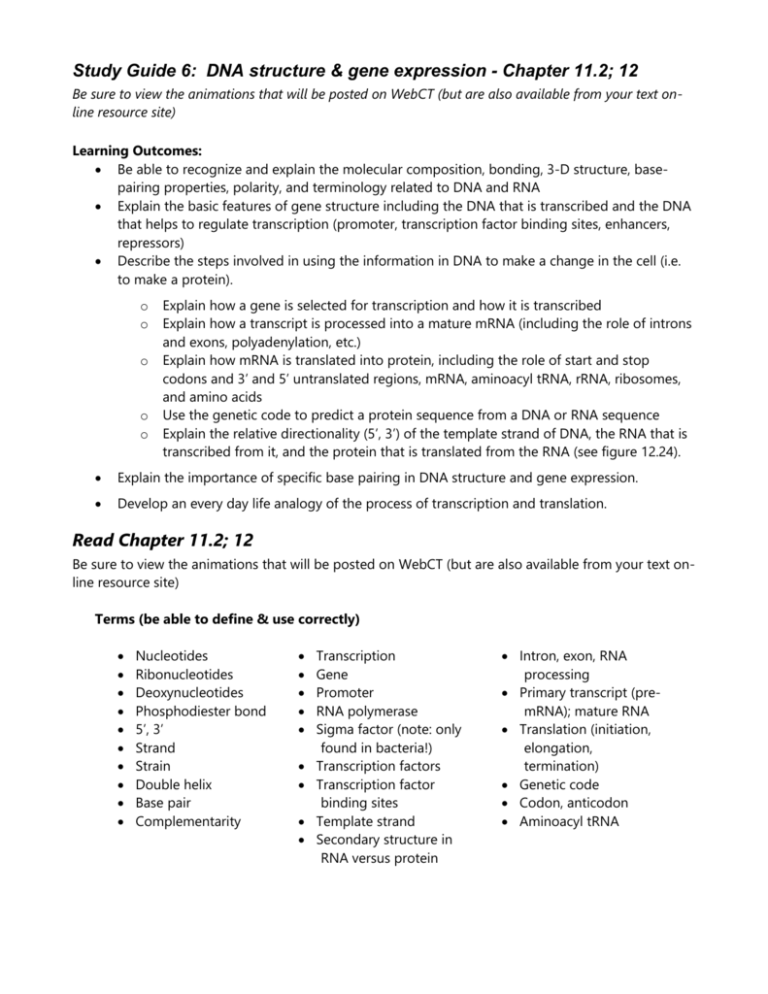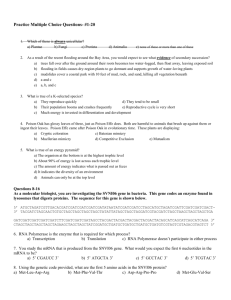Study Guide 6: DNA structure & gene expression
advertisement

Study Guide 6: DNA structure & gene expression - Chapter 11.2; 12 Be sure to view the animations that will be posted on WebCT (but are also available from your text online resource site) Learning Outcomes: Be able to recognize and explain the molecular composition, bonding, 3-D structure, basepairing properties, polarity, and terminology related to DNA and RNA Explain the basic features of gene structure including the DNA that is transcribed and the DNA that helps to regulate transcription (promoter, transcription factor binding sites, enhancers, repressors) Describe the steps involved in using the information in DNA to make a change in the cell (i.e. to make a protein). o o o o o Explain how a gene is selected for transcription and how it is transcribed Explain how a transcript is processed into a mature mRNA (including the role of introns and exons, polyadenylation, etc.) Explain how mRNA is translated into protein, including the role of start and stop codons and 3’ and 5’ untranslated regions, mRNA, aminoacyl tRNA, rRNA, ribosomes, and amino acids Use the genetic code to predict a protein sequence from a DNA or RNA sequence Explain the relative directionality (5’, 3’) of the template strand of DNA, the RNA that is transcribed from it, and the protein that is translated from the RNA (see figure 12.24). Explain the importance of specific base pairing in DNA structure and gene expression. Develop an every day life analogy of the process of transcription and translation. Read Chapter 11.2; 12 Be sure to view the animations that will be posted on WebCT (but are also available from your text online resource site) Terms (be able to define & use correctly) Nucleotides Ribonucleotides Deoxynucleotides Phosphodiester bond 5’, 3’ Strand Strain Double helix Base pair Complementarity Transcription Gene Promoter RNA polymerase Sigma factor (note: only found in bacteria!) Transcription factors Transcription factor binding sites Template strand Secondary structure in RNA versus protein Intron, exon, RNA processing Primary transcript (premRNA); mature RNA Translation (initiation, elongation, termination) Genetic code Codon, anticodon Aminoacyl tRNA Study Guide 6: DNA structure & gene expression - Chapter 11.2; 12 Be sure to view the animations that will be posted on WebCT (but are also available from your text online resource site) Common Misconceptions to Avoid • The relationship between genes and proteins is often a difficult concept for people to understand. Most genes code for proteins. Other genes are transcribed into RNA but the RNA is not translated into proteins, (for example, tRNA and rRNA). So, the proteins and RNA produced by the genes, not the genes themselves, determine the characteristics of an organism. • People often think that only one of the DNA strands is transcribed, and that the other one does nothing. However, transcription is occurring at multiple sites on any given DNA strand. So, parts of each of the strands in a DNA double helix are transcribed, but neither of the two strands is transcribed in its entirety. • People do not always grasp the importance of the universal nature of the genetic code. Every organism on the planet uses the same language. However, a universal genetic code does not mean that all organisms have the same DNA sequences. • In the translation process, people often are not sure where the amino acids come from. One common misconception is that the tRNA actually synthesizes them. Amino acids are synthesized by enzymes in the cytoplasm or imported into the cytoplasm from outside the cell. An enzyme covalently attaches the right amino acid to the right tRNA.








